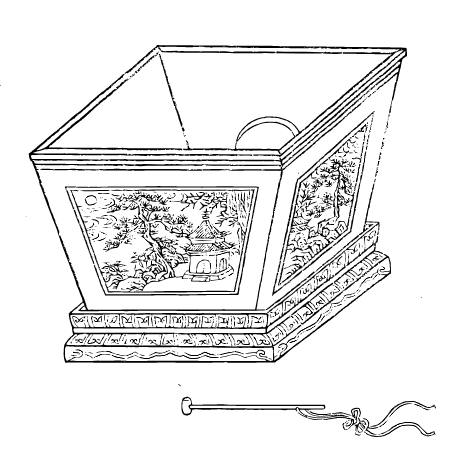
The zhu (pinyin: zhù) is a Chinese Han Dynasty musical instrument, a square, percussion instrument struck with a wooden stick. It has been circulated in major cities across the country. It belongs to the "wood" in the "octave". It is used for court music, and when it is struck, it indicates the beginning of the music. According to legend, it was written by Xia Qi, and it has a history of more than 4,000 years. "Book of Songs, Zhou Song, You Gu" records: "Zhuqing Zhuwei", "zhu" means zhu, so zhu is also called "zhu". The tree is shaped like a big bucket and is made of wood. During the performance, the player holds the vertebra and bumps the tower to signal the beginning of the movement to other players and the rhythm of the movement. It is only used at the beginning of ancient court music and sacrificial music. Similar to the function of yu, they both indicate the beginning and the end of music. The ancient book also mentioned "Shangshu·Yiji": "He stops zhu yu".
-
Pinyin:zhù
-
type:percussion
-
period:夏朝
reference materials and contributors
-
柷 · 百度百科
-
柷 · 搜狗百科
-
柷 · 维基百科
overview of other similar instruments
 The zhu (pinyin: zhù) is a Chinese Han Dynasty musical instrument, a square, percussion instrument struck with a wooden stick. It has been circulated in major cities across the country. It belongs to the "wood" in the "octave". It is used for court music, and when it is struck, it indicates the beginning of the music. According to legend, it was written by Xia Qi, and it has a history of more than 4,000 years. "Book of Songs, Zhou Song, You Gu" records: "Zhuqing Zhuwei", "zhu" means zhu, so zhu is also called "zhu". The tree is shaped like a big bucket and is made of wood. During the performance, the player holds the vertebra and bumps the tower to signal the beginning of the movement to other players and the rhythm of the movement. It is only used at the beginning of ancient court music and sacrificial music. Similar to the function of yu, they both indicate the beginning and the end of music. The ancient book also mentioned "Shangshu·Yiji": "He stops zhu yu".
The zhu (pinyin: zhù) is a Chinese Han Dynasty musical instrument, a square, percussion instrument struck with a wooden stick. It has been circulated in major cities across the country. It belongs to the "wood" in the "octave". It is used for court music, and when it is struck, it indicates the beginning of the music. According to legend, it was written by Xia Qi, and it has a history of more than 4,000 years. "Book of Songs, Zhou Song, You Gu" records: "Zhuqing Zhuwei", "zhu" means zhu, so zhu is also called "zhu". The tree is shaped like a big bucket and is made of wood. During the performance, the player holds the vertebra and bumps the tower to signal the beginning of the movement to other players and the rhythm of the movement. It is only used at the beginning of ancient court music and sacrificial music. Similar to the function of yu, they both indicate the beginning and the end of music. The ancient book also mentioned "Shangshu·Yiji": "He stops zhu yu".  渝公网安备 50010702504639号
渝公网安备 50010702504639号